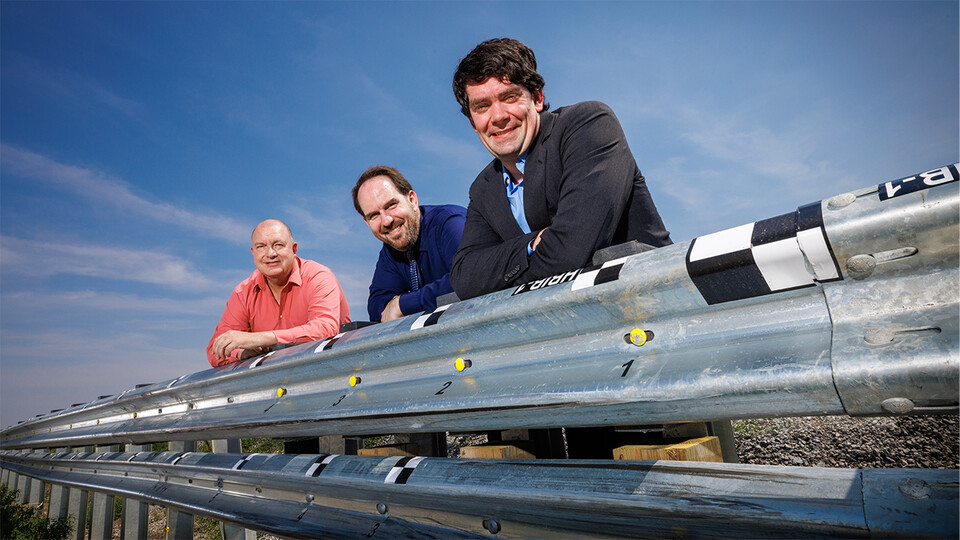That shift has introduced a different issue, and a new challenge, for the University of Nebraska–Lincoln’s Cody Stolle and his colleagues at the Midwest Roadside Safety Facility. But the researchers are focusing on more than just the safety of EV passengers. The Husker engineers are also gearing up to protect those who could be targeted by the vehicles: in this case, American soldiers stationed at the 1,000-plus U.S. military installations at home and abroad.
With the aid of $3.6 million in funding from the U.S. Army’s Engineer Research and Development Center, research teams at Nebraska and Auburn University are working to safeguard the entry points of military bases against the specific threats posed by hostile-driven EVs.
“EVs are a different kind of an animal compared to gasoline vehicles,” said Stolle, assistant director of the Nebraska-housed Midwest Roadside Safety Facility and a research assistant professor of mechanical and materials engineering.
For starters, an EV battery so outweighs the engine of a gas-powered vehicle that the EV itself will often carry hundreds or even thousands of extra pounds in total. An EV carries that weight differently, too, with a center of gravity lower than its conventional counterpart. Despite the added heft, an electric motor also produces torque almost immediately after foot meets pedal, lending it a zero-to-60 acceleration that puts most internal combustion engines to shame.
The Nebraska team will be accounting for each of those factors, plus others, in refining barriers that ring the perimeters of U.S. military bases and protect the gated checkpoints used by friendly vehicles. Stolle said those passive barriers — whose designs can range from guardrails to post-like bollards — must be engineered to withstand high-speed ramming from EVs, which make up a growing percentage of the world’s automotive fleet.
“While they have many similarities to traditional vehicle counterparts, they’re not the same, and they will change the way that we design roadside hardware,” said Stolle, whose Nebraska team will receive $2.2 million of the funding over four years. “And it is beneficial for all of us to be prepared for a transition of any volume of our vehicle fleet toward electrification, because it means that we’re going to have to design to accommodate a broader swath of possibilities.
“The current study is a bedrock establishment of all the parameters necessary to ensure that (military) bases are able to handle vehicles of all types, whether gasoline or electric or even new technologies which have yet to be created.”
To devise and test their designs, the team — which includes Ronald Faller, research professor and director of the Midwest Roadside Safety Facility; Joshua Steelman, associate professor; and others — will employ a combination of the digital and the tangible. The former will include the most sophisticated modeling and simulations of classical mechanics on the planet. Some of those in-house computer simulations can model general vehicular dynamics, especially the ways that the forces acting on any one component will influence the behavior of another.
The engineers are also receiving support from Ansys, whose software can simulate the energy transfer of a collision by effectively isolating certain variables, then integrating the results into larger models on a millisecond-by-millisecond basis. Another donation, from Caresoft Global, will provide the team with comprehensive modeling specific to EVs.
“That’s a pretty substantial donation; there are very few of these models available in the world,” Stolle said. “So the fact that we have access to them is a huge research advantage, and it will greatly enable us to evaluate more complex phenomena.”
But the Husker team will regularly test its designs in the physical world, too, pitting them against the brute force of, say, a 15,000-pound truck slamming bumper-first into a barrier at 50 miles per hour. Those crash tests will take place roughly every three months over the next four years, each marking a chance to evaluate refinements and incorporate the lessons imparted by twisted metal.
The Midwest Roadside Safety Facility is no stranger to model-based simulations or crash tests. The facility relied on both while developing the Steel and Foam Energy Reduction (SAFER) Barrier System, which was installed at Indianapolis Motor Speedway in 2002 and now lines the walls of nearly every oval track driven by IndyCar and NASCAR. It did the same when designing the Midwest Guardrail System, a “flagship product” that has emerged as the standard across U.S. highways and been adopted throughout much of Asia, Africa and Australia.
Just as the SAFER barrier informed the design of the Midwest Guardrail System, Stolle said, the latter is informing the team’s approach to passive barriers at U.S. military bases. But whereas the facility’s two signature civilian-centered projects were designed to cushion and redirect crashes occurring at oblique angles, the team is now engineering against head-on impacts. That can mean weathering up to three times the energy of a glancing, unintentional crash.
“Most of our highway guardrail applications are designed to handle impact forces and structural requirements on the order of between 10,000 and 50,000 pounds. System which are designed for big trucks may have to withstand 200,000 or 300,000 pounds over the contact footprint,” he said. “Well, anti-ram barrier systems have to do that, too, but they have to do it over (just) a couple of feet, not spread over an entire system.
“That changes the way that you design these systems, so that their capacities are much higher. And we’re using innovative technologies to accomplish that purpose.”
Stolle, who has been at the University of Nebraska–Lincoln since enrolling as a freshman in 2004, said the team has good reason to think it will. In the mid-2010s, with Stolle early into his postdoctoral appointment, several branches within the Department of Defense approached the Midwest Roadside Safety Facility for its input on anti-ram barriers. Under the guidance of John Reid, now a professor emeritus, Stolle found himself thrust into the opportunity and responsibility.
“They put me on as a young postdoc and said, ‘Hey, why don’t you help out with this project?’ Fast forward: Now we are consulting with core DOD agencies to make cost-effective, efficient and universal designs for safety.”
Several of the facility’s designs have since made their way onto U.S. military bases. Knowing that those engineering improvements have saved and will save lives, Stolle said, ranks atop the many reasons he loves working at the MwRSF.
“It’s fantastic,” he said. “It’s the best part about this job.”



